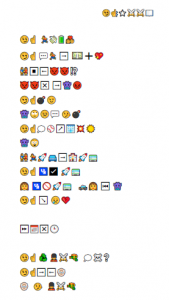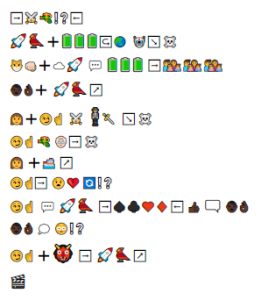Task 6: An Emoji Story



During the composing process, I quickly noticed that I needed to signify nouns, verbs and adjectives to depict the plot summary of the film I chose. Characters could not simply be named, so I instead set out to represent them with one or more emojis, for instance. This is when I chose to juxtapose two emojis as morphemes that communicated a character’s identity based on one or more defining traits. I “re-named” my protagonist by using an emoji, the smirk, to capture the character’s default traits of both self-assuredness and mischief. This brought to mind how, in Homer’s The Odyssey, its eponymous hero is frequently referred to as “crafty”—the trait he must rely on to return home and restore his place. The villainous antagonist is denoted by his business suit and dagger, which suggest both his status and treachery.
When I wanted to convey actions or interactions, I used arrows to denote actions; thought and speech callouts indicated the character was thinking or saying something. Conveniently, speech callouts existed in left and right forms. I borrowed from the convention of comics and graphic novels, where characters may be located on either side of a panel while their interaction happens in the centre. The process parallels what Kress (2005) describes the “materiality of sound” which, in this case was my manipulating “spaces, lines, spatial separation and connection through punctuation marks of various kinds” (p. 14). In this way, space can denote the passage of time where it is otherwise not visually stated.
In this process, I shared Kress’ (2005) doubts about the extent to which my conventions could even be understood by an audience unfamiliar with the film. I also began to question Kress’ (2015) assertion that, “unlike words, depictions are full of meaning; they are always specific” (p. 15). While this is may be true of singular images, it nonetheless ignores the influence both juxtaposition and context. Morphemes juxtaposed into composite words not only have precise denotation, but also contextual connotations as well. Likewise, Emojis may develop connotative meanings that have emerged from the context in which they are used—especially when innuendo or euphemism are intended. One colleague in the course, Eduardo, used an open book emoji to denote the verb “learn”. I used the same one to denote “story”. I had little difficulty decoding the emoji within the context of the line of song lyrics. Overall, the restrictive nature of this activity was what also allowed for unconventional and inventive use of two familiar modes of writing. Bolter’s (2001) near-contemptuous view of visual media seems, in hindsight, as misplaced as his belief that video would simply replace written language.
References
Bolter, J.D. (2001). Chapter 4: The breakout of the visual. In Bolter, J.D. Writing space: Computers, hypertext, and the remediation of print (2nd ed., pp. 47-76). Routledge. https://doi.org/10.4324/9781410600110
Kress, G. (2005). Gains and losses: New forms of texts, knowledge, and learning. Computers and Composition 2(1), 5-22. https://doi:10.1016/j.compcom.2004.12.004